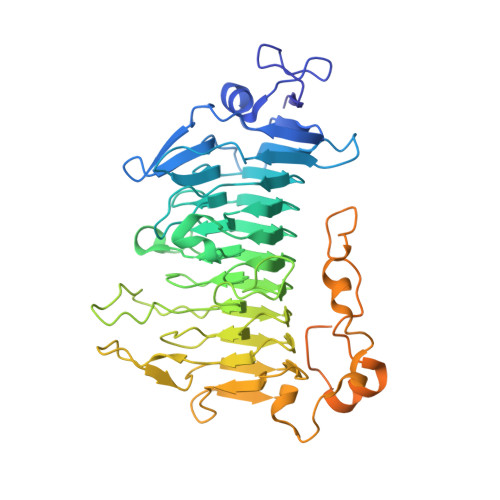Dietary pectic glycans are degraded by coordinated enzyme pathways in human colonic Bacteroides.
Luis, A.S., Briggs, J., Zhang, X., Farnell, B., Ndeh, D., Labourel, A., Basle, A., Cartmell, A., Terrapon, N., Stott, K., Lowe, E.C., McLean, R., Shearer, K., Schuckel, J., Venditto, I., Ralet, M.C., Henrissat, B., Martens, E.C., Mosimann, S.C., Abbott, D.W., Gilbert, H.J.(2018) Nat Microbiol 3: 210-219
- PubMed: 29255254
- DOI: https://doi.org/10.1038/s41564-017-0079-1
- Primary Citation of Related Structures:
5OLP, 5OLQ, 5OLR, 5OLS, 5OPJ - PubMed Abstract:
The major nutrients available to human colonic Bacteroides species are glycans, exemplified by pectins, a network of covalently linked plant cell wall polysaccharides containing galacturonic acid (GalA). Metabolism of complex carbohydrates by the Bacteroides genus is orchestrated by polysaccharide utilization loci (PULs). In Bacteroides thetaiotaomicron, a human colonic bacterium, the PULs activated by different pectin domains have been identified; however, the mechanism by which these loci contribute to the degradation of these GalA-containing polysaccharides is poorly understood. Here we show that each PUL orchestrates the metabolism of specific pectin molecules, recruiting enzymes from two previously unknown glycoside hydrolase families. The apparatus that depolymerizes the backbone of rhamnogalacturonan-I is particularly complex. This system contains several glycoside hydrolases that trim the remnants of other pectin domains attached to rhamnogalacturonan-I, and nine enzymes that contribute to the degradation of the backbone that makes up a rhamnose-GalA repeating unit. The catalytic properties of the pectin-degrading enzymes are optimized to protect the glycan cues that activate the specific PULs ensuring a continuous supply of inducing molecules throughout growth. The contribution of Bacteroides spp. to metabolism of the pectic network is illustrated by cross-feeding between organisms.
Organizational Affiliation:
Institute for Cell and Molecular Biosciences, Newcastle University, Newcastle upon Tyne, UK.
















